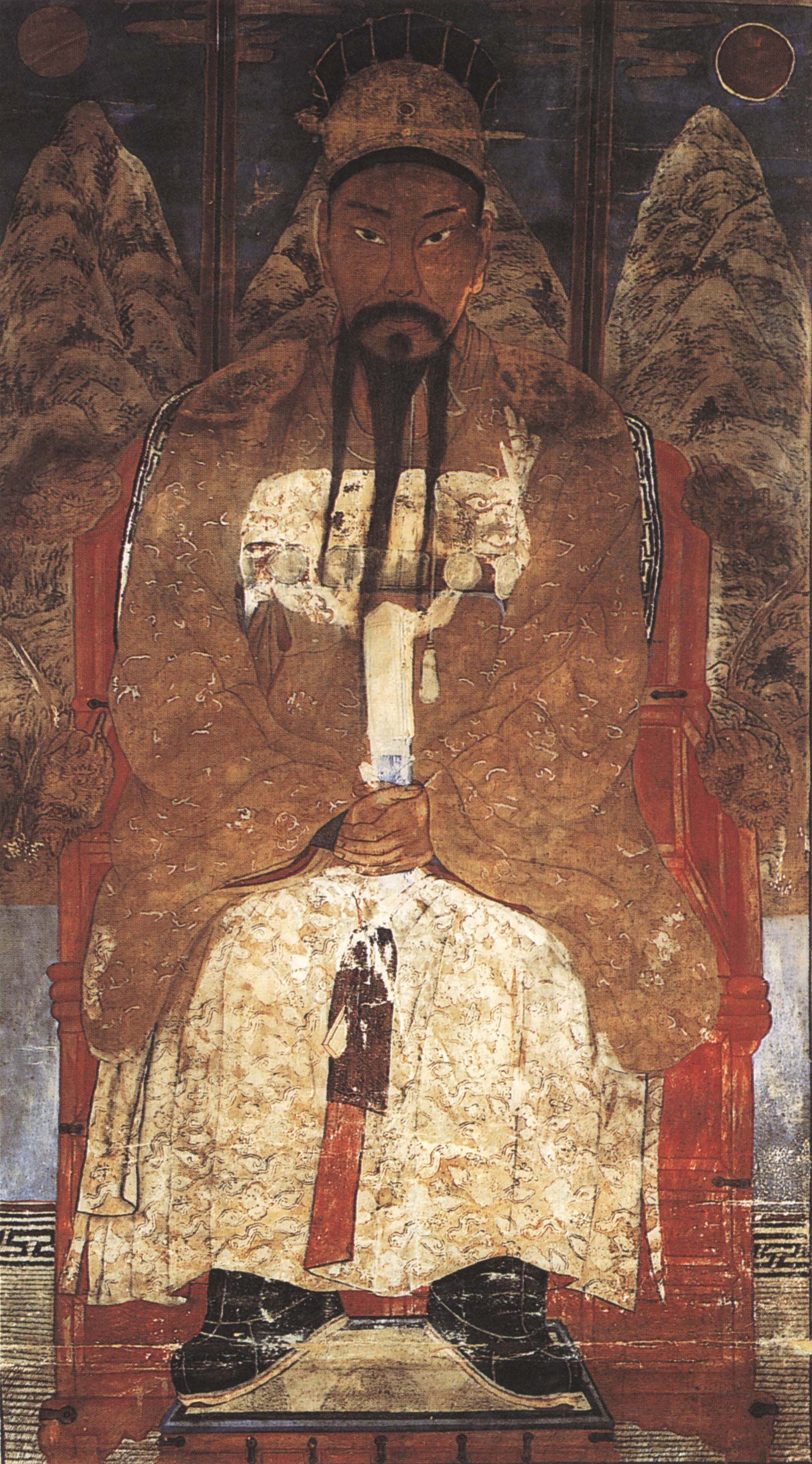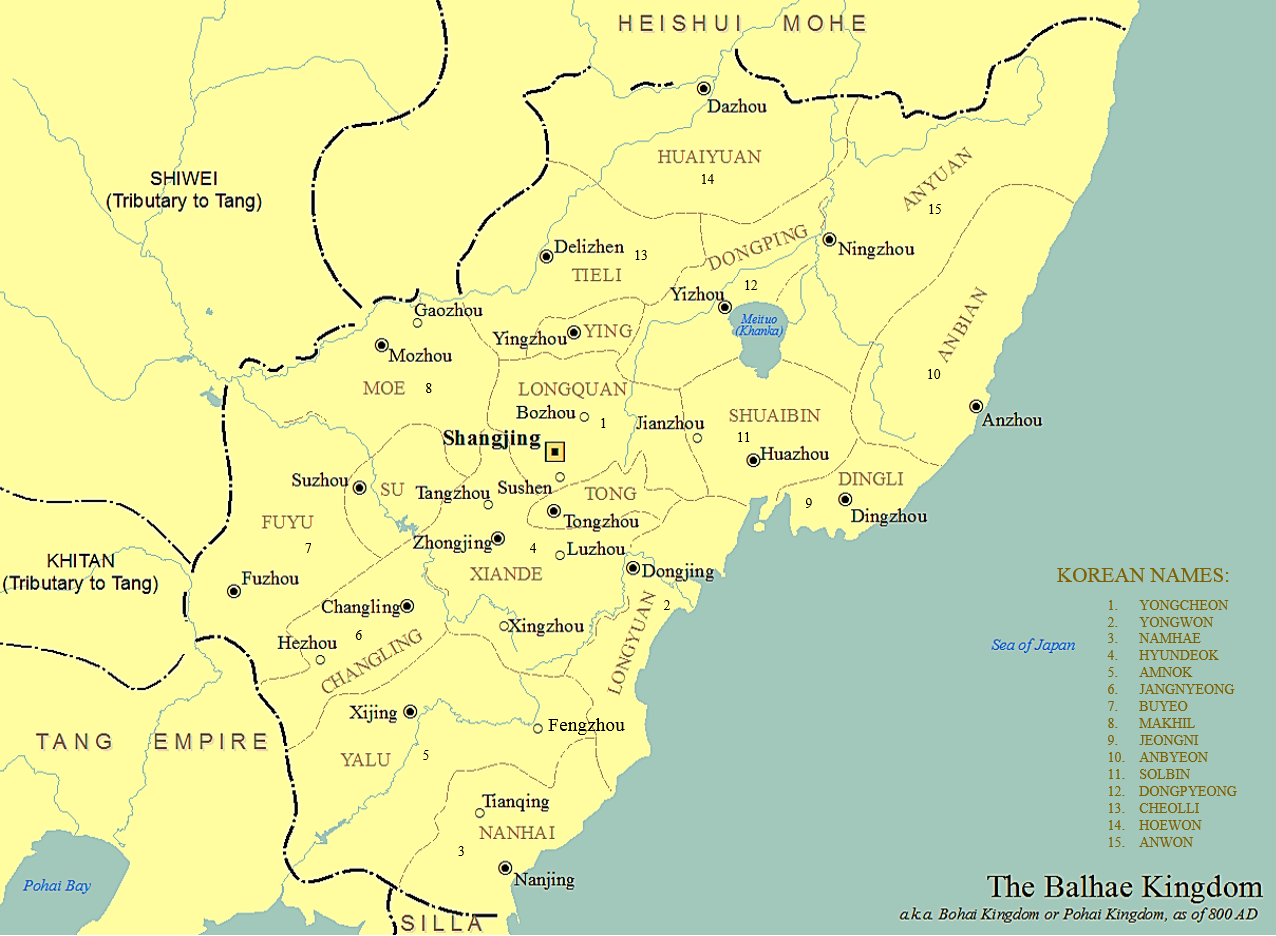|
Dae Geonhwang
Geonhwang of Balhae (r. 857–871) was the 12th king of Balhae. He was the younger brother of Dae Ijin, his predecessor on the throne. Because none of Balhae's own records have survived, we know little of Geonhwang except that he sent a few missions to Japan and Tang China. See also *List of Korean monarchs *History of Korea The Lower Paleolithic era in the Korean Peninsula and Manchuria began roughly half a million years ago. Christopher J. Norton, "The Current State of Korean Paleoanthropology", (2000), ''Journal of Human Evolution'', 38: 803–825. The earlies ... References Balhae monarchs 871 deaths 9th-century rulers in Asia {{Korea-bio-stub ... [...More Info...] [...Related Items...] OR: [Wikipedia] [Google] [Baidu] |
Balhae
Balhae ( ko, 발해, zh, c=渤海, p=Bóhǎi, russian: Бохай, translit=Bokhay, ), also rendered as Bohai, was a multi-ethnic kingdom whose land extends to what is today Northeast China, the Korean Peninsula and the Russian Far East. It was established in 698 by Dae Joyeong (Da Zuorong) and originally known as the Kingdom of Jin (Zhen) until 713 when its name was changed to Balhae. Balhae's early history involved a rocky relationship with the Tang dynasty that saw military and political conflict, but by the end of the 8th century the relationship had become cordial and friendly. The Tang dynasty would eventually recognize Balhae as the "Prosperous Country of the East". Numerous cultural and political exchanges were made. Balhae was conquered by the Khitan-led Liao dynasty in 926. Balhae survived as a distinct population group for another three centuries in the Liao and Jin dynasties before disappearing under Mongol rule. The history of the founding of the state, its ... [...More Info...] [...Related Items...] OR: [Wikipedia] [Google] [Baidu] |
Dae Ijin
Dae Ijin (r. 830–857) was the 11th king of the Balhae kingdom, which existed from AD 698 to 926 and occupied parts of Manchuria and northern Korea. The era name of his reign was ''Hamhwa'' (咸和, 함화). New Book of Tang,北狄,"子新德蚤死,孫彝震立,改年鹹和。明年,詔襲爵。終文宗世來朝十二,會昌凡四" He was preceded by his grandfather, Seon of Balhae. The king made efforts for the consolidation of a centralized administrative system and organized a standing army. See also *List of Korean monarchs *History of Korea The Lower Paleolithic era in the Korean Peninsula and Manchuria began roughly half a million years ago. Christopher J. Norton, "The Current State of Korean Paleoanthropology", (2000), ''Journal of Human Evolution'', 38: 803–825. The earlies ... References 857 deaths Balhae rulers 9th-century rulers in Asia Year of birth unknown {{Korea-bio-stub ... [...More Info...] [...Related Items...] OR: [Wikipedia] [Google] [Baidu] |
Japan
Japan ( ja, 日本, or , and formally , ''Nihonkoku'') is an island country in East Asia. It is situated in the northwest Pacific Ocean, and is bordered on the west by the Sea of Japan, while extending from the Sea of Okhotsk in the north toward the East China Sea, Philippine Sea, and Taiwan in the south. Japan is a part of the Ring of Fire, and spans an archipelago of 6852 islands covering ; the five main islands are Hokkaido, Honshu (the "mainland"), Shikoku, Kyushu, and Okinawa. Tokyo is the nation's capital and largest city, followed by Yokohama, Osaka, Nagoya, Sapporo, Fukuoka, Kobe, and Kyoto. Japan is the eleventh most populous country in the world, as well as one of the most densely populated and urbanized. About three-fourths of the country's terrain is mountainous, concentrating its population of 123.2 million on narrow coastal plains. Japan is divided into 47 administrative prefectures and eight traditional regions. The Greater Tokyo Ar ... [...More Info...] [...Related Items...] OR: [Wikipedia] [Google] [Baidu] |
Tang China
The Tang dynasty (, ; zh, t= ), or Tang Empire, was an imperial dynasty of China that ruled from 618 to 907 AD, with an interregnum between 690 and 705. It was preceded by the Sui dynasty and followed by the Five Dynasties and Ten Kingdoms period. Historians generally regard the Tang as a high point in Chinese civilization, and a golden age of cosmopolitan culture. Tang territory, acquired through the military campaigns of its early rulers, rivaled that of the Han dynasty. The Lǐ family () founded the dynasty, seizing power during the decline and collapse of the Sui Empire and inaugurating a period of progress and stability in the first half of the dynasty's rule. The dynasty was formally interrupted during 690–705 when Empress Wu Zetian seized the throne, proclaiming the Wu Zhou dynasty and becoming the only legitimate Chinese empress regnant. The devastating An Lushan Rebellion (755–763) shook the nation and led to the decline of central authority in the dynast ... [...More Info...] [...Related Items...] OR: [Wikipedia] [Google] [Baidu] |
List Of Korean Monarchs
This is a list of monarchs of Korea, arranged by dynasty. Names are romanized according to the South Korean Revised Romanization of Korean. McCune–Reischauer romanizations may be found at the articles about the individual monarchs. Gojoseon Gojoseon (2333 BC – 108 BC) was the first Korean kingdom. According to legend, it was founded by Dangun in 2333 BC. Bronze Age archaeological evidence of Gojoseon culture is found in northern Korea and Liaoning. By the 9th to 4th century BC, various historical and archaeological evidence shows Gojoseon was a flourishing state and a self-declared kingdom. Both Dangun and Gija are believed to be mythological figures, but recent findings suggest and theorize that since Gojoseon was a kingdom with artifacts dating back to the 4th millennium BC, Dangun and Gija may have been royal or imperial titles used for the monarchs of Gojoseon, hence the use of Dangun for 1900 years. * :"An extreme manifestation of nationalism and the family cult was t ... [...More Info...] [...Related Items...] OR: [Wikipedia] [Google] [Baidu] |
History Of Korea
The Lower Paleolithic era in the Korean Peninsula and Manchuria began roughly half a million years ago. Christopher J. Norton, "The Current State of Korean Paleoanthropology", (2000), ''Journal of Human Evolution'', 38: 803–825. The earliest known Korean pottery dates to around 8000 BC, and the Neolithic period began after 6000 BC, followed by the Bronze Age by 2000 BC, Jong Chan Kim, Christopher J Bae, "Radiocarbon Dates Documenting The Neolithic-Bronze Age Transition in Korea" , (2010), ''Radiocarbon'', 52: 2, pp. 483–492. and the Iron Age around 700 BC. Similarly, according to ''The History of Korea'', supervised by Kim Yang-ki and edited by Kang Deoksang, Jung Sanae, and Nakayama K ... [...More Info...] [...Related Items...] OR: [Wikipedia] [Google] [Baidu] |
Dae Hyeonseok
Dae Hyeonseok (died 894) was the 13th king of Balhae who reigned from 871 to 894. Dae Geonhwang was his grandfather. During his reign, he sent tribute to tang dynasty china three times. New Book of Tang,"彝震死, 弟虔晃立. 死, 玄錫立. 咸通時, 三朝獻." His son was Dae Wihae. See also *List of Korean monarchs *History of Korea The Lower Paleolithic era in the Korean Peninsula and Manchuria began roughly half a million years ago. Christopher J. Norton, "The Current State of Korean Paleoanthropology", (2000), ''Journal of Human Evolution'', 38: 803–825. The earlies ... References Balhae monarchs 894 deaths 9th-century monarchs in Asia {{Korea-bio-stub ... [...More Info...] [...Related Items...] OR: [Wikipedia] [Google] [Baidu] |
Balhae Monarchs
Balhae ( ko, 발해, zh, c=渤海, p=Bóhǎi, russian: Бохай, translit=Bokhay, ), also rendered as Bohai, was a multi-ethnic kingdom whose land extends to what is today Northeast China, the Korean Peninsula and the Russian Far East. It was established in 698 by Dae Joyeong (Da Zuorong) and originally known as the Kingdom of Jin (Zhen) until 713 when its name was changed to Balhae. Balhae's early history involved a rocky relationship with the Tang dynasty that saw military and political conflict, but by the end of the 8th century the relationship had become cordial and friendly. The Tang dynasty would eventually recognize Balhae as the "Prosperous Country of the East". Numerous cultural and political exchanges were made. Balhae was conquered by the Khitan-led Liao dynasty in 926. Balhae survived as a distinct population group for another three centuries in the Liao and Jin dynasties before disappearing under Mongol rule. The history of the founding of the state, ... [...More Info...] [...Related Items...] OR: [Wikipedia] [Google] [Baidu] |
871 Deaths
__NOTOC__ Year 871 ( DCCCLXXI) was a common year starting on Monday (link will display the full calendar) of the Julian calendar. Events By place Europe * The English retreat onto the Berkshire Downs. The Great Heathen Army, led by the Danish Viking kings Halfdan and Bagsecg, march out after the Saxons. Six pitched battles are fought between the Danes and Wessex. Of two of them the place and date are not recorded, the others are: ** January 4 – Battle of Reading: A West Saxon force, under the command of King Æthelred I and his brother Alfred, is defeated by the Danes at Reading. Among the many dead on both sides is Æthelwulf. The Saxon troops are forced to retreat, allowing the Vikings to continue their advance into Wessex. ** January 8 – Battle of Ashdown: The West Saxons, led by Æthelred I and Alfred, gather at the Berkshire Downs. The Danes under the command of Halfdan and Bagsecg occupy the high ground, but are successfully attacked by Alfred ... [...More Info...] [...Related Items...] OR: [Wikipedia] [Google] [Baidu] |





